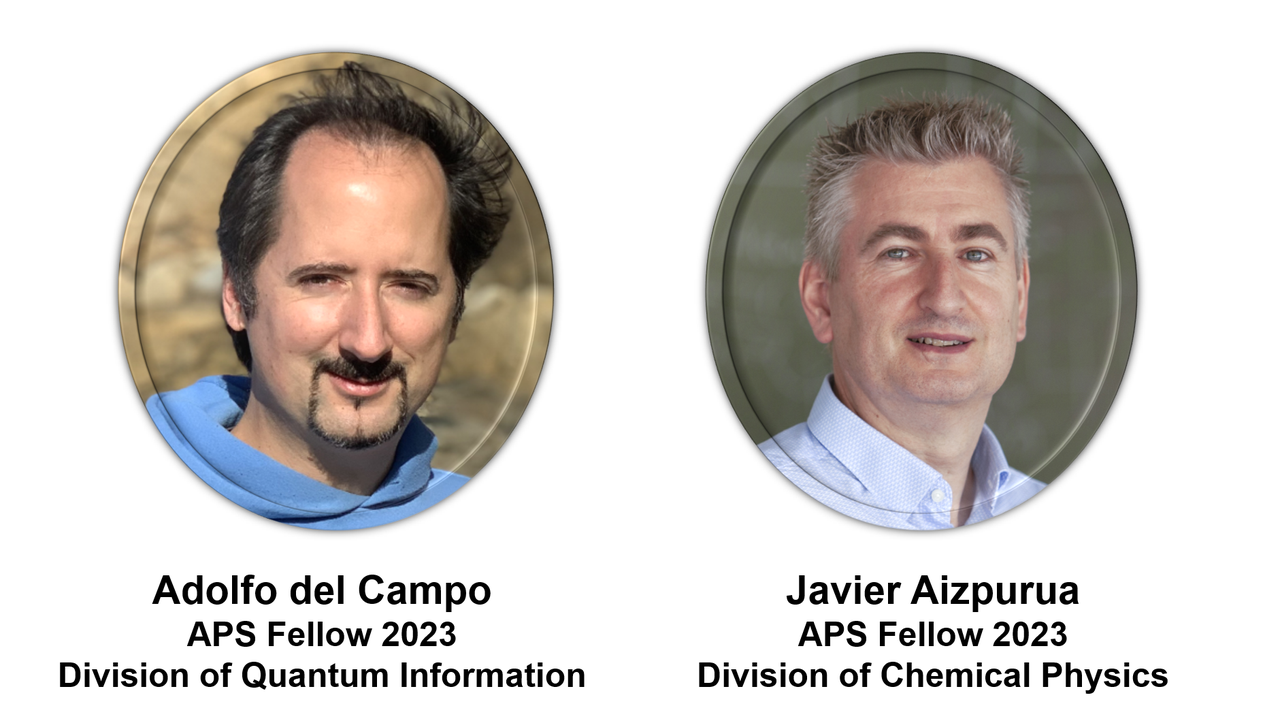Adolfo del Campo and Javier Aizpurua, elected Fellows of the American Physical Society 2023

Adolfo del Campo and Javier Aizpurua have been elected Fellows of the American Physical Society 2023 recognizing their contributions to quantum and chemical physics, respectively.
Adolfo del Campo (University of Luxembourg, DIPC Associate) “For pioneering contributions to the development of shortcuts to adiabaticity in many-body systems and the study of phase transition dynamics generalizing the Kibble-Zurek mechanism”.
Javier Aizpurua (Materials Physics Center - CFM/CSIC, DIPC Associate) “For seminal contributions to the theory of nanoplasmonics that have led to fundamental advances in our understanding of light-matter interactions at the nanoscale and the atomic scale, including quantum plasmonics and nanometrology”.
The APS Fellowship Program was created to recognize members who may have made exceptional contributions in physics through original research and publication, or made significant innovative contributions in the application of physics to science and technology. Each nomination is evaluated by the Fellowship committee of the appropriate APS division, topical group or forum, or by the APS General Fellowship committee. Fellowship is a distinct honor signifying recognition by one's professional peers. Each year, no more than one half of one percent of the Society’s membership (excluding student members) is recognized by their peers for election to the status of Fellow of the American Physical Society.
Both DIPC associated researchers have shared their thoughts on this prestigious recognition:
Adolfo del Campo: "As a student at the UPV/EHU I had the opportunity to meet in person two giants of physics, Tom W. B. Kibble and Wojciech Zurek. That was a long time ago, in 2003, thanks to the COSLAB event organized in Bilbao. Perhaps as a result of that, I started working on their ideas years later as a postdoc at Imperial College London. I also had the opportunity to collaborate with them when I worked as an Oppenheimer Fellow at Los Alamos National Laboratory. The APS recognizes my contributions on phase transitions by generalizing a paradigm known as the Kibble-Zurek mechanism, in their honor... The fellowship also recognizes as pioneering my contributions to the development of shortcuts to adiabaticity in complex systems, which I pushed as a postdoc for fast control of quantum systems. A decade later they are used by many scientists and several companies working at the frontier of quantum computing developing quantum algorithms, such as Kipu Quantum... I am passionate about research and it is an important part of my life. The pace is rather frenetic and there is a lot of "noise". But having and developing good ideas requires concentration and calm. I hope to be able to contribute other ideas of interest in the future. I still see science as an art, in which intuition, curiosity and aesthetic value are the best guides, and inspiration and creative strokes bring essential value and make the experience somewhat magical... Having spent many years in the United States, where I was also a teacher, the recognition of the APS is very special to me".
Javier Aizpurua: "My first paper as a PhD student was a Physical Review B paper, one of the canonical journals in Condensed Matter Physics in the APS family at that time, and even nowadays. APS was always a lighthouse to look at when trying to do serious and interesting Physics, therefore I am particularly thankful for being selected as an APS Fellow this year. Since my first contributions on field-enhanced molecular spectroscopy, together with Peter Apell, Mikael Käll, and Hongxing Xu, in Göteborg, my career was positively influenced through the years by many excellent researchers with strong links to APS. During my time in the US, I was particularly enlightened by Garnett Bryant at NIST, as well as by Peter Nordlander and Naomi Halas in Houston to focus on quantum aspects of plasmonic excitations, and their interaction with molecules. Finally, back in Europe, together with Andrei Borissov in Paris Saclay, Jeremy Baumberg in Cambridge, and Rainer Hillenbrand, in San Sebastian, the beauty of the interaction of photons, electrons and photons in molecular species sandwiched by metallic gaps was often addressed in the context of APS journals and meetings. I hope this outcome can continue in future equally nicely within the APS environment."
